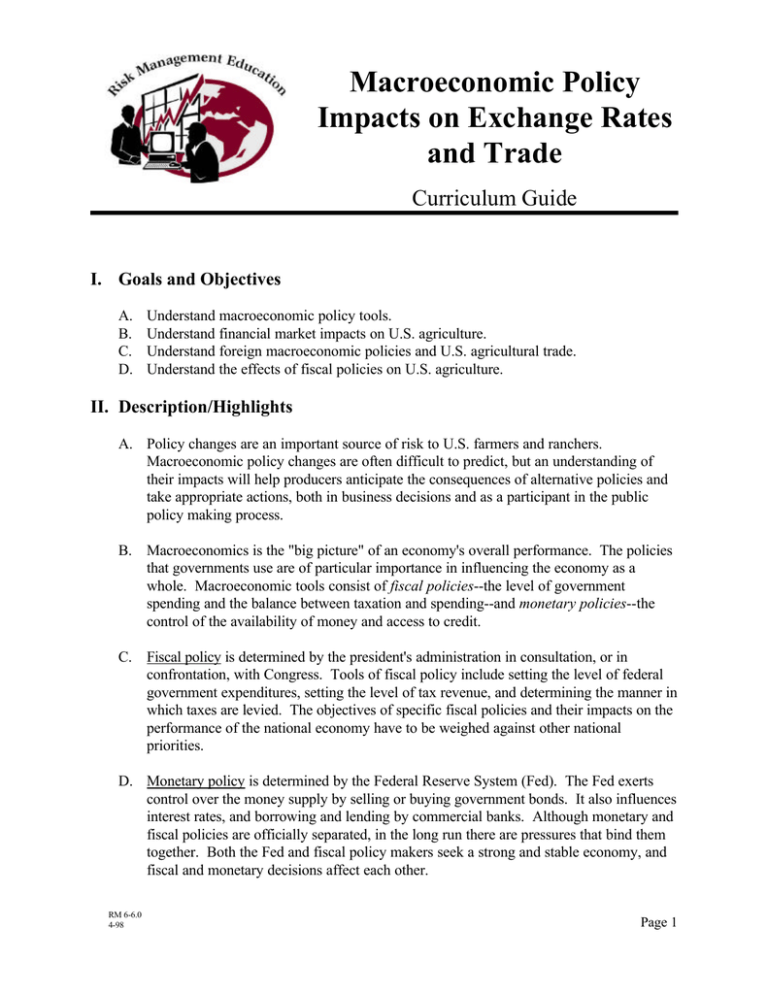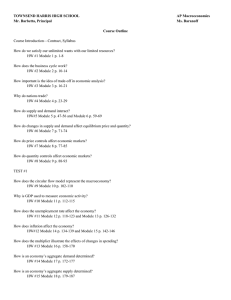Macroeconomic Policy Impacts on Exchange Rates and Trade Curriculum Guide
advertisement

Macroeconomic Policy Impacts on Exchange Rates and Trade Curriculum Guide I. Goals and Objectives A. B. C. D. Understand macroeconomic policy tools. Understand financial market impacts on U.S. agriculture. Understand foreign macroeconomic policies and U.S. agricultural trade. Understand the effects of fiscal policies on U.S. agriculture. II. Description/Highlights A. Policy changes are an important source of risk to U.S. farmers and ranchers. Macroeconomic policy changes are often difficult to predict, but an understanding of their impacts will help producers anticipate the consequences of alternative policies and take appropriate actions, both in business decisions and as a participant in the public policy making process. B. Macroeconomics is the "big picture" of an economy's overall performance. The policies that governments use are of particular importance in influencing the economy as a whole. Macroeconomic tools consist of fiscal policies--the level of government spending and the balance between taxation and spending--and monetary policies--the control of the availability of money and access to credit. C. Fiscal policy is determined by the president's administration in consultation, or in confrontation, with Congress. Tools of fiscal policy include setting the level of federal government expenditures, setting the level of tax revenue, and determining the manner in which taxes are levied. The objectives of specific fiscal policies and their impacts on the performance of the national economy have to be weighed against other national priorities. D. Monetary policy is determined by the Federal Reserve System (Fed). The Fed exerts control over the money supply by selling or buying government bonds. It also influences interest rates, and borrowing and lending by commercial banks. Although monetary and fiscal policies are officially separated, in the long run there are pressures that bind them together. Both the Fed and fiscal policy makers seek a strong and stable economy, and fiscal and monetary decisions affect each other. RM 6-6.0 4-98 Page 1 E. Interest rates closely and inextricably link U.S. agriculture to national financial markets in a number of ways. Agriculture is particularly sensitive to interest rates because it is one of the most capital intensive industries in the economy. Interest rates can influence variable production costs by raising or lowering the payments required for short-run planting-to-harvest borrowing. They also affect the cost of long-term capital investments. The interdependence of world financial markets also has important implications for U.S. agriculture. F. High interest rates in the United States relative to the rest of the world ultimately have a detrimental effect on U.S. agricultural exports. Foreign investors become eager to invest their funds in U.S. financial markets, and to do this they must buy dollars with their foreign currency, generating a high demand for U.S. dollars. With the floating exchange rate system in operation since 1973, exchange rate values are generally an expression of demand for a country's currency. A high demand for U.S. dollars induced by high domestic interest rates or other factors thus manifests itself as an appreciation of the dollar, which makes U.S. exports less competitive in world markets. G. On the global scene, implementation of the Uruguay Round Agreements (URA) under the General Agreement on Tariffs and Trade (GATT), is expected to create growth in U.S. agricultural exports and net farm income over the next decade. Trade liberalization was at least partly responsible for the doubling of both Mexican and Canadian imports of U.S. agricultural goods between 1988 and 1994 (USDA Outlook for Agricultural Exports, 1994). The North American Free Trade Agreement (NAFTA) will stimulate further growth. H. Economic growth also brings about changes in the preferences of a nation's consumers, which has an impact on the demand for U.S. agricultural exports. Many developing countries are demanding more high-valued goods and less bulk commodities. Their changing preferences reflect rising incomes, trade liberalization, and the relative decline of their own agricultural sectors in the process of development (USDA Outlook for Agricultural Exports, 1994). I. Unchecked government spending can fuel inflation by generating excess demand for goods and services in the economy. However, fears of such inflationary deficit spending must be balanced against the positive effects government spending can have on national income and employment growth. Domestic income growth, like world income growth, creates demand for farm products, and high levels of non-farm employment create opportunities for some farm people to seek other jobs. Conversely, when economic growth slows down, demand for farm products is reduced. J. For agriculture, fiscal constraints led to successive cuts in farm program support. By 1994, annual outlays for commodity credit programs had fallen 70 to 80 percent from the historically high levels in 1986 (USDA Agricultural Outlook, 1994). The 1994 elections elevated budgetary considerations to an even higher priority and this, plus high market prices, led to the near elimination of farm price support programs. RM 6-6.0 4-98 Page 2 K. During the 1990s, the United States has enjoyed an unusually long period of sustained growth, low inflation, and stable interest rates. While deflation is a concern, so far it has resulted only in stable interest rates rather than interest rate reductions. In the mid1990s, the U.S. dollar strengthened, especially relative to currencies in Asia and Latin America. A recession in Asia, coupled with a stronger U.S. dollar, will lead to a larger U.S. trade deficit. The large devaluation of currencies in Thailand and Indonesia, and the rapidity with which their economies contracted, emphasize the risks faced by agriculture that are often beyond the immediate control of U.S. policy makers. III. Potential Speakers A. B. C. D. Extension Economists Global Business Managers National or State Government Officials Marketing Club Leaders IV. Review Questions A. What are the two Macroeconomic Policy Tools and who executes them? Monetary and Fiscal Policy are the tools. Monetary Policy is the authority to tax and spend and it is carried out by the President’s administration in consultation, or in confrontation, with Congress. Fiscal Policy is control of the nation’s money supply and it is carried out by the Federal Reserve System. B. Do high interest rates have a positive or negative impact on U.S. exports? Why? High interest rates lower U.S. exports because they cause the dollar to appreciate, causing U.S. goods to be more expensive for foreign buyers and less competitive when compared to foreign competition and exports to decline. Downward pressure on farm prices also results. C. How does economic growth in foreign nations affect demand for U.S. exports? As incomes rise consumption preferences change and high-valued goods are demanded, and in many cases more bulk commodities. Demand for U.S. goods increases resulting in higher farm prices. V. For More Details International Trade Leaflet Series, Leaflets 5, and 6. http://agrinet.tamu.edu/intlagmktg/ RM 6-6.0 4-98 Page 3 Macroeconomic Policy Impacts on Exchange Rates and Trade ! Macroeconomic Policy Tools L Fiscal policy - Authority to tax and spend - Government expenditures - Tax revenues L Monetary policy - Money supply growth - Discount rates & interest rates - Exchange rate - Importance of buying and selling of U.S. bonds ! Financial Market Impacts on U.S. Agriculture L L RM 6-6.0 4/98 Interest rates affect borrowing and exchange rate U.S. dollar affects U.S. exports Page 1 Macroeconomic Policy Impacts on Exchange Rates and Trade ! Foreign Macroeconomic Policies and U.S. Agricultural Trade L L L L ! Fiscal Policy Issues L L L RM 6-6.0 4/98 U.S. and world growth rates Interest rates affect U.S. foreign demand Foreign economic performance influences U.S. exports Foreign market availability determines demand Federal spending influences exchange rates Domestic income and growth increase Demand for U.S. farm products Fiscal constraints produced cuts in farm support programs Page 2 Macroeconomic Policy Impacts on Exchange Rates and Trade Fig. 1 U.S. Federal Budget and Merchandise Trade Deficits, 1980-93 0 -50 $ Bil. -100 -150 -200 -250 -300 1980 1984 Budget Deficit RM 6-6.0 4/98 1988 1992 Trade Deficit Page 3





